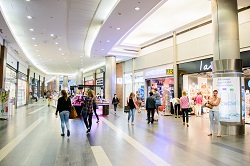Energy-efficient solutions retrofitted to commercial buildings
Commercial properties can achieve significant energy savings by refurbishing the building envelope and applying easy-to-install and cost-effective building services solutions. These improvements in the building’s operation and maintenance can also contribute to a more sustainable, cleaner and healthier built environment. The EcoShopping project developed holistic retrofitted solutions for commercial buildings that reduce primary energy consumption to less than 80 kWh/m2per year. The initiative also increased the share of renewable energy sources (RES) to more than 50 % compared to the state of the art. This was achieved by developing novel thermal insulation systems based on cost-effective materials that further reduce thermal losses and energy consumption. Easy-to-install light emitting diodes together with daylighting technologies that use natural light illumination system also improved comfort and reduced bills. The retrofitted heating, ventilation and air conditioning system was based on harnessing the buildings’ thermal mass, photovoltaic-powered heat pumps and a next-generation capillary tube system for radiant heating and cooling. Greater control gives greater savings This approach was founded on an integrated environmental and acoustic sensor network complete with a mobile robot platform. Project coordinator Enrique Grosser Lagos says: ‘The network gives a cheap, energy-efficient yet adaptable system that monitors the occupancy level, temperature, humidity and noise in buildings and surrounding areas, transferring the data in near real-time to the intelligent automisation unit (IAU).’ The IAU serves as the brain of the building to give greater control in terms of time, cost and demand, resulting in greater energy efficiency. Furthermore, the system’s status can be compared to historic data to identify faults and ineffectiveness within the system. ‘A web platform was also developed, allowing the building operator to plan the maintenance schedule better, thereby reducing energy consumption and avoiding unexpected interruptions in service,’ comments Grosser Lagos. These technologies were demonstrated in the IKVA shopping centre located in Sopron, western Hungary in order to test them under real-world conditions. ‘The goal was to enhance the energy efficiency of the shopping centre by increasing its use of RES and simplify its operation and maintenance, while providing optimal indoor environmental quality and comfort for a safe, healthy and sustainable environment,’ explains Grosser Lagos. Importance of working together Demonstrating EcoShopping included establishing a lab environment within the shopping centre, where the technologies could be easily implemented and the results precisely measured. This enabled project partners to learn about implementation issues and how to overcome them, whilst providing instant feedback from stakeholders and end users. By working closely together, tenants, owners and researchers realised it was vital to integrate each other’s efforts and interests in order to successfully retrofit energy-saving systems. EcoShopping involved different fields of research covering insulation, daylighting, RESs, computing, communication, performance optimisation and construction. It will also create new market opportunities and related economic benefits through a new business model for the building sector, resulting in new management services for SMEs and creation of energy service companies.
Keywords
EcoShopping, commercial building, retrofitting, energy saving, renewable energy

